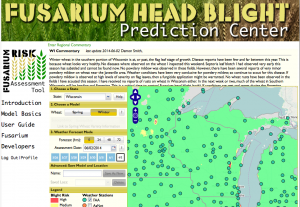Wisconsin Winter Wheat Disease Update – June 2, 2014
Damon L. Smith – Extension Field Crops Pathologist, University of Wisconsin
Winter wheat in the southern portion of Wisconsin is at, or past, the flag leaf stage of growth. Disease reports have been few and far between this year. This is because wheat looks very healthy. No diseases where observed on the wheat I inspected this weekend. Septoria leaf blotch I had observed very early this season has subsided and cannot be found now. No powdery mildew was observed in these fields. However, there have been several reports of very minor powdery mildew on wheat near the Janesville area. Weather conditions have been very conducive for powdery mildew, so continue to scout for this disease. If powdery mildew is observed at high levels of severity on flag leaves, then a fungicide application might be warranted.
No wheat rusts have been observed in the fields I have scouted this season. I have received no reports of rusts on wheat in Wisconsin either.
In the next week or two, much of the wheat in Southern Wisconsin will be heading and flowering. This is a critical time to control Fusarium head blight (scab). If conditions are wet and warm during the flowering (anthesis) period, the risk for scab will be higher. To assist in making decisions about scab management, consult the Fusarium Head Blight Prediction Center at http://www.wheatscab.psu.edu. Currently, the risk for scab is low in most of the state. However, as temperatures get warmer and if it continues to rain, the risk can increase quickly.
If a fungicide is warranted for control of scab, products such Prosaro, Caramba, or similar that contain triazole active ingredients can offer suppression of scab and reduce deoxynivalenol (DON) accumulation in harvested grain. These products should be applied within a week or so of the beginning of flowering for reasonable control. Products containing strobilurin fungicides should be avoided on wheat that has headed. Research has demonstrated that levels of DON can be higher after treatment with strobilurin products after heading.
Continue to scout wheat regularly over the next couple of weeks. This will be a critical time to make in-season disease management decisions.



